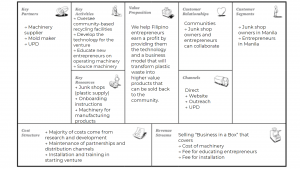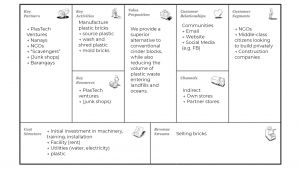- Develop a detailed income statement for your venture for two years (at six month intervals). Explicit state the assumptions that underlie your financial model.
Revenue Stream:
- Business in a Box
- Sale of machinery
- Installation fee
- Initial training fee (entrepreneur and staff)
- Service Contract: Maintenance plan
- Additional/advanced training for new staff
Cost Structure:
COGS:
- Machinery
- Cost of machinery, purchased from fabrication shop
- Personnel (Employee):
-
- Assembly of and quality check on machinery
- Dispatch people to do maintenance
- Training of new entrepreneurs and laborers
- Commission for sales team
- Travel for installation, maintenance, and trainings
- Cost to ship machinery
-
Operating Costs (Overhead):
- Staff
- Marketing and sales
- Public relations/grant-writer
- Operations
- Office space rental
- Utilities
- Office supplies (e.g. computer, stationeries, etc.)
- Travel for maintenance of network
2. Identify two SPECIFIC funding sources for the design phase of your project and two SPECIFIC funding sources for the dissemination (implementation / distribution / commercialization) phase of your project. For each funding source, explain why this is a good fit for your project, and what SPECIFIC aspect of your project might the funding source support.
-
-
- Venture Well (Design Phase): Venturewell provides funding to tech startups during their early stage. PlasTech Venture is in their early stage where the team is working on finalizing a wall system design. Funding from VentureWell can go towards testing the effects of contamination on the material properties of recycled plastics. In addition, the funding can also go towards prototyping the machinery to produce the plastic products.
- Draper Richards Kaplan Foundation (Design Phase): DRK provides 3 year funding of $300,000 to early stage startup ventures (1-3 years old) whose goal is to provide solutions to big problems that will create lasting positive impact. PlasTech Venture fits the primary requirement for DRK. Funding will go towards prototyping machinery and products, testing contamination concepts, and aid in travel costs for the venture.
- Roddenberry Foundation -The Catalyst Fund (Implementation Phase):The fund is geared towards small/ early stage ideas that need capital to launch or prove viability. PlasTech Venture is an early stage venture and will need funding to launch the first venture in Paradise village Manila, Philippines. Funding will subsidize some of the cost to the first (maybe more, depending on the funding) entrepreneur who will be interested in investing in PlasTech Venture’s business in a box strategy. The money will be used to offset some of the cost associated with installing the machinery at the facility and providing training to workers in operating the machinery.
- Government/Barangays (Implementation Phase) – Barangays in the Philippines have a decentralization law in place that breaks down waste at the barangay level. Future funding for implementation could come from this source. Since barangays already took the initial necessary step to help combat the plastic waste crisis, they will likely fund our community-based recycling model to encourage a larger scale of people to turn their plastic waste into something that can be used again. This funding could assist PlasTech Ventures in covering some of its costs or could incentivize local citizens to use one of our machines; the government could enact a reward system for citizens that bring their used plastic materials to a facility that has our machines to promote community-based recycling.
-
3. Identify five specific partnerships that you need to forge to advance your project forward with the ultimate goal of positively impacting at least one million people. Describe exactly how that partnership might help you achieve scale and why that entity might be willing to work with you.
-
-
-
- Manufacturing Company (Caterpillar, Inc.?): The partnership with the manufacturing company would be beneficial to the team by acting as a supplier for the machinery component of our business in a box strategy. The Manufacturer would be willing to work for our company because they earn a profit for each machinery they build. These machinery will receive a quality inspection.
- Philippine Plastic Industry Association: The partnership will aid the team in making sure that the products that will be manufactured and the machinery operation process will meet Philipino standards. PPIA will be willing to work with PlasTech Venture because they are interested in minimizing environmental impacts associated with plastics along with ensuring the well-being of Flippino.
- Plastic Tides (NGO): This partnership will help us by becoming the first entrepreneur to invest and purchase our business in a box solution. Plastic Tides will be willing to work with us because we share a common goal of eliminating plastic pollution. The business in a box package will allow the company to ensure that the plastic that is collected from the beach will not end up back in the ocean. Plastic Tides would also obtain another source of income to sustain the organization.
- Local Construction Company in Manila Philippines (Gold Leaf Construction?):This partnership would allow us to promote our products to the construction company and establish credibility in the industry. The construction company would like to partner with us because they would be interested in alternative construction materials that can meet their needs while reducing their material costs and increasing their ease in assembly.
- A junk shop in Manila (Jirah Junk Shop): This partnership would allow the venture to establish a plastic supplier for our clients who will purchase our business in a box package in order to create products out of plastic. The junk shop will be willing to work with us because this is a business opportunity for them to sell their plastics.
-
-


